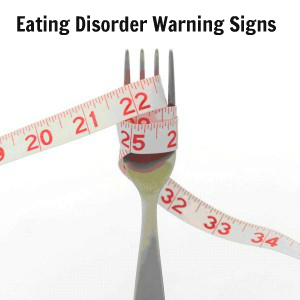 Some behavioural signs can be quite hard to pick up on but some are really strong clear indicators that a young person is suffering from an eating disorder. The thing with many of these signs is that on their own they can usually be explained away, but if you see them in combination, or you’re noticing them in someone who has personality, family or social factors that put them at higher risk of eating disorders, they could be a clear indicator that someone is suffering from an eating disorder.
Some behavioural signs can be quite hard to pick up on but some are really strong clear indicators that a young person is suffering from an eating disorder. The thing with many of these signs is that on their own they can usually be explained away, but if you see them in combination, or you’re noticing them in someone who has personality, family or social factors that put them at higher risk of eating disorders, they could be a clear indicator that someone is suffering from an eating disorder.
It’s all about building up a picture of the individual and once you know all the different things to look out for you’ll have a much better idea of whether a student needs further support or help. In addition to the behavioural warning signs listed below, there are physical warning signs that a young person might be suffering from and eating disorder which you should also be on the lookout for.
Restricted eating
Restricted eating, or dieting can be an indicator of an eating disorder. Of course there could be dozens of students in any year group who are dieting at any one time and not all of these will develop eating disorders, but any student who seems to be on a very severe diet and appears to be excessively restricting what they eat should be a cause for concern.
Skipping meals
Rather than simply restricting their intake at mealtimes, many students will skip meals altogether. This can be rather more difficult to spot in many schools (you might notice a student who leaves a lot of their dinner but would you know for sure that someone simply hadn’t turned up?) but if you do become aware of meal skipping it is a potential warning sign that should be explored.
Scheduling activities during lunch
A really busy schedule during lunchtimes can leave a pupil without time to eat their lunch – or act as a distraction to stop them thinking about eating if they are forcing themselves to fast. Like many of the warning signs, lunchtime activities alone do not indicate an eating disorder but can be an indicator that helps form part of a bigger picture.
Strange behaviour around food
People with eating disorders will often have strange rituals that they carry out during meal times. They may, for example, cut their food up very small, or eat their food in a particular order. They may also experience distress around food and in more severe examples may even suffer from panic attacks. Any of these behaviours should flag this student as a cause for concern.
Wearing baggy clothes
Students with very low self-esteem about their appearance will often hide their bodies under baggy clothes. It is also very common for anorexics to hide their weight loss under oversized clothes.
Wearing several layers of clothing
As we discussed earlier, anorexics tend to feel very cold all the time due to lack of fat. For this reason you’ll often see them wearing multiple layers, even when the weather doesn’t feel that cold.
Excessive chewing of gum/drinking of water
Chewing gum, and drinking can be used both to cover the smell of vomit in a bulimic and as a distraction for any eating disorders sufferer trying to prevent themselves from eating.
Increasing isolation / loss of friends
Students suffering from an eating disorder will often distance themselves from their friends as they become more and more wrapped up in their disorder. You should be particularly concerned if previously popular pupils appear to be distancing themselves from their peers, particularly if they are exhibiting other warning signs or fit into any of the at risk categories we discussed before.
Believes they’re fat when they’re not
This is a classic symptom of eating disorders. Pupils with eating disorders often see themselves as if looking in a fairground mirror that makes them appear fat the whole time. Pupils of normal weight who express concerns about being fat could be a cause for concern.
Secretive behaviour
Eating disorders are quite secretive diseases. Bulimia in particular usually involves secretive eating and purging. If you note an increase in secretive behaviour, or a pupils’ friends express concern about this kind of behaviour to you, it shouldn’t be dismissed.
Visits the toilet immediately after meals
Many eating disorders sufferers, especially bulimics, will visit the toilet immediately after a meal to vomit. If you note this pattern it should be a cause for concern.
You don’t need to remember all of the warning signs, just being aware of some of the things to look out for and having a better understanding about how eating disorders might make people act and who is more likely to suffer will mean that you’re far more likely to pick up causes for concern, even if you don’t remember everything discussed here.


By Caraway Clinic September 21, 2024 - 6:30 pm
Just wanted to say - what a well written article; and how useful both for parents and those working with young people. We are so often asked at Caraway, what the signs are to look out for - a list like this is so useful.